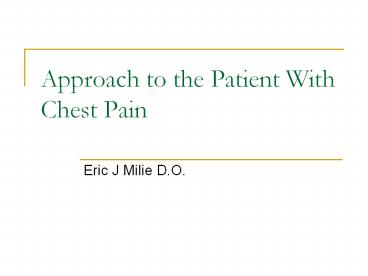Approach to the Patient With Chest Pain - PowerPoint PPT Presentation
1 / 20
Title:
Approach to the Patient With Chest Pain
Description:
Approach to the Patient With Chest Pain Eric J Milie D.O. Objectives Establish a differential diagnosis for the patient with chest pain Recognize clues in the history ... – PowerPoint PPT presentation
Number of Views:1061
Avg rating:3.0/5.0
Title: Approach to the Patient With Chest Pain
1
Approach to the Patient With Chest Pain
- Eric J Milie D.O.
2
Objectives
- Establish a differential diagnosis for the
patient with chest pain - Recognize clues in the history and physical exam
to rule in or rule out various etiologies of
chest pain - Outline a basic treatment strategy for the
treatment of a patients chest pain
3
General
- Rule out most medically critical causes of chest
pain first - General appearance of the patient
- Look through the chart
- Good history
4
Differential
- Ischemia or infarction
- PE
- Pneumothorax
- Pericarditis
- Tamponade
- Pneumonia
- Aortic Dissection
- GERD
- Shingles
- Musculoskeletal
5
Myocardial Infarction/ Ischemia History
- Pressure type pain (elephant on chest)
- Central to left sided pain, radiation to jaw
- Worse with activity, relieved with rest
- Relief with nitro
- Nausea, diaphoresis, syncope, SOB
- Enquire about risk factors HTN, hyperlipid,
diabetes, previous cardiac history, smoker,
family history, etc - Pain within six feet of the chest in a diabetic
is an MI until proven otherwise.
6
Physical
- Appearance Does the patient look ill?
- Levines sign
- Hypotension cardiogenic shock
- Bradycardia high grade block
- Tachycardia sichemia related tachyarrhythmia
- Increased JVD, palpable liver, peripheral edema
Right sided heart failure - Crackles, S3 left sided failure
7
Levines Sign
80 sensitive, but only 51 specific
8
Investigations
- EKG Should be knee jerk response to any chest
pain, SOB, etc - CXR Rule out heart failure, anatomical cause for
pain - Cardiac enzymes Not always initially positive.
CKMB will begin to rise within 6 hours, elevated
for 48 hours, troponin rises within 12 hours,
elevated for two weeks
9
Treatment
- Morphine
- Oxygen
- Nitro
- Aspirin
- Lasix (if failure)
- Inotropes (if shock)
- Streptokinase, TPA, Retaplase, or Integrillin if
EKG criteria met (discuss with attending) - Anticoagulate (heparin)
10
Pulmonary Embolus
- Sudden onset of sharp chest pain
- Worse with inspiration
- Anxious patient, sense of impending doom
- Risk factors immobilization, venous
insufficiency, trauma, known DVT, pregnancy,
malignancy, clotting disorder
11
PE Physical
- Anxious
- Tachycardia, tachypnea, hypoxia
- Hypotension and syncope possible
- Look for unilateral calf swelling
12
Investigations
- ABG ?PaO2 and PaCO2
- CXR Frequently normal
- EKG nonspecific ST/T changes or sinus
tachycardia most common (classic S1Q3T3 seen in
less than 11 of known PEs) - D-Dimer Sensitive but not specific lag time of
up to 24 hours here - Spiral CT of the chest quick, easy with good
sensitivity and specificity
13
Management
- Anticoagulate with wt based heparin, TPA only if
hemodynamically unstable from large saddle
embolus - Supportive treatment with fluids, oxygen
- Intubate if unable to maintain oxygenation or
patient fatiguing
14
Pneumothorax History
- Acute pleuritic chest pain or dyspnea
- Primary pneumo in young, healthy, tall, thin
white males - Secondary procedures (CVP), ruptured bleb in
COPD patient, barotrauma (bagging during code,
improper vent settings), or necrotic
neumonia/empyema
15
Physical
- Decreased expansion of the chest
- Hyperresonnant percussion
- If tension pneumo, may see deviation of traches
and progressive hypotension, decreased cardiac
output- emergency
16
Investigation
- Chest x-ray
17
(No Transcript)
18
(No Transcript)
19
Management
- Watchful waiting for small, asymptomatic pneumo
- Chest tube for large, hemodynamically unstable
- Emergent large bore needle to the 2nd
intercostal space, midclavicular line
20
(No Transcript)































